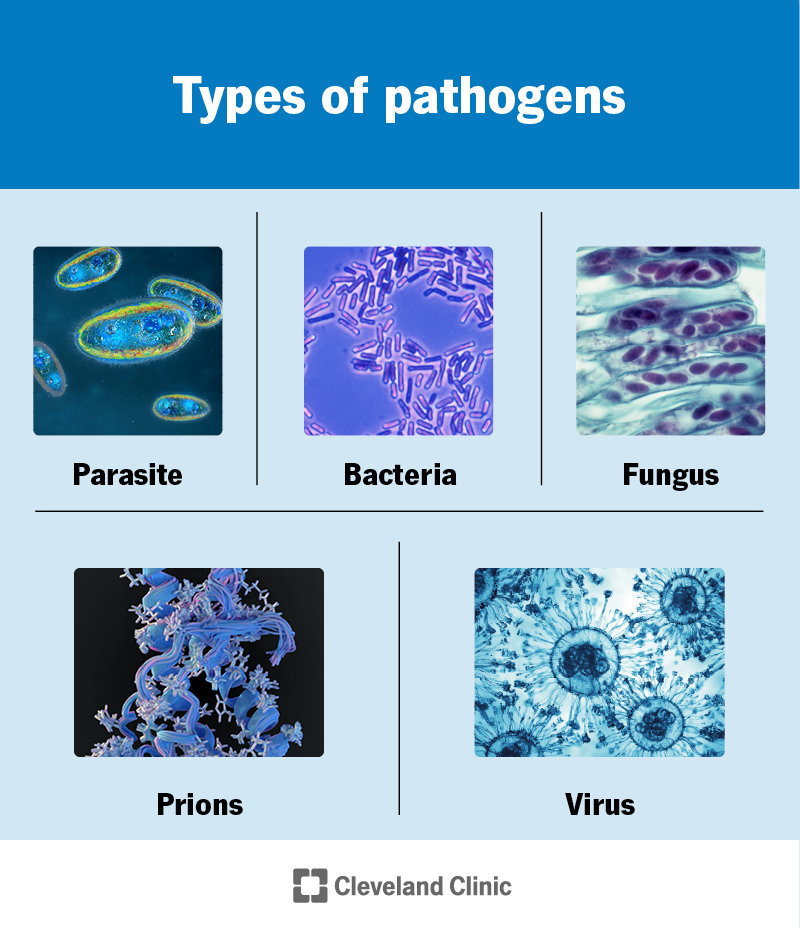Pathogens are tiny organisms that can make you sick if they get inside your body. Viruses, bacteria, fungi, parasites and prions are pathogens. They’re commonly called germs. Handwashing, disinfecting surfaces and safe food preparation can reduce your risk of getting infected with a pathogen.
Advertisement
Cleveland Clinic is a non-profit academic medical center. Advertising on our site helps support our mission. We do not endorse non-Cleveland Clinic products or services. Policy

Pathogens are microorganisms that can make you sick. A microorganism is something that’s so small, you need a microscope to see it. Pathogens can cause illnesses like common colds, food poisoning, stomach bugs, tickborne illnesses, STIs — and almost anything else that you can catch from other people or from the environment around you. They’re commonly called germs.
Advertisement
Cleveland Clinic is a non-profit academic medical center. Advertising on our site helps support our mission. We do not endorse non-Cleveland Clinic products or services. Policy
Pathogens can infect people, animals and plants. Even pathogenic organisms, like bacteria and fungi, have their own pathogens. For instance, some antibiotics are made from fungi that kill bacteria.
Most pathogens only infect specific species, like one type of animal. But some can jump from one species to another, like from an animal to a human (zoonotic diseases). Bugs — like mosquitoes, ticks or fleas — can also spread some pathogens by biting you. When this happens, the bugs that spread them are called vectors.
Types of pathogens include:
Some types of these organisms live on or inside your body without making you sick. They can even be helpful by protecting you from the harmful germs. Only the germs that hurt us are called pathogens.
Advertisement
There are thousands of human pathogens. Some examples of common ones include:
Pathogens can enter your body through your mouth, nose or any other mucous membrane (part of your body that opens to the outside). They can also enter through cuts in your skin. Once inside your body, they reproduce (make more copies of themselves) and damage your cells. Some, like certain bacteria, also release toxins that make you sick.
You don’t always get sick when you’re exposed to a pathogen. Sometimes — especially if you’ve been infected with it already — your immune system can fight it off before you have noticeable symptoms.
Pathogens can spread through:
The symptoms you get when a pathogen infects you depend on the type. Some common symptoms include:
Washing your hands, disinfecting surfaces and safe food preparation (like cooking meats thoroughly) are usually the best ways to get rid of pathogens before they infect you. If you’re sick, your provider might prescribe medications to help get rid of them. Depending on the type of infection, these could include:
Vaccines can also train your body to recognize specific pathogens so you can fight them off more easily if you’re exposed to them.
For something so small, pathogens can cause a lot of harm. Fortunately, simple habits like handwashing and safe food prep can go a long way to keep you from getting sick. When a cold virus or stomach bug does get through, your immune system is there to help get you healthy again.
Advertisement
Cleveland Clinic’s primary care providers offer lifelong medical care. From sinus infections and high blood pressure to preventive screening, we’re here for you.

Last reviewed on 06/17/2025.
Learn more about the Health Library and our editorial process.